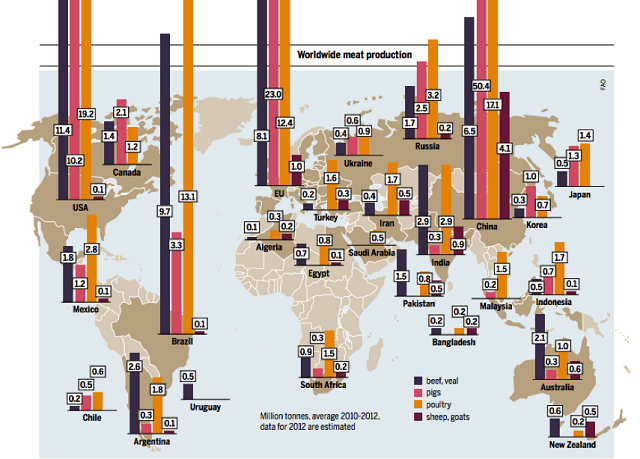
In the Americas, three nations prevail as leading consumers and producers of beef: the United States, Brazil, and Argentina. From burgers to filet mignon, beef is often considered a staple food, even a delicacy. Its consumption is deeply ingrained in some cultures, but only a few understand the impact of industrial demand of cattle products. Most people are not aware that beef production is directly responsible for producing vast levels of greenhouse gases and expanding deforestation, especially in the Amazon forest region. In fact, in the past 25 years forests with an area the size of India have been cleared in Central and South America.[1] Although demand for beef has stagnated in the U.S. and certain Latin American countries, worldwide consumption continues to expand, and producers in the Western hemisphere are eager to supply. In fact, the Food and Agriculture Organization (FAO) predicts that beef production and consumption will double by 2050, a situation that can ultimately be costly to the environment.[2] The article does not attempt to promote the eradication of beef from the personal diet, but to present an argument for the preservation of the environment, which includes a decrease in current levels of consumption, as well as innovative farming practices.
In terms of production, the U.S. takes the lead with an average of 11 million tons produced per year, followed by Brazil with 9.7 million tons and Argentina with 2.6 million tons.[3] In the U.S., people consume an average of three hamburgers a week, resulting in 156 burgers a year per person.[4] Argentina has historically been a prime consumer, and in the 1960s citizens consumed about 222 pounds per person every year. Beef plays a central role in the culture and identity of Argentina, so much so that in the 1990s former President Carlos Menem once joked, “Don’t come to my country if [you’re] vegetarian.”[5] Today, their consumption is slightly lower at about 129 pounds per person, but it is still well above the global average of 58.4 pounds per person a year.[6] Even though certain countries have reduced their consumption, overall worldwide trends indicate that beef-lovers are on the rise, especially in developing countries.
Patterns of beef consumption in developed countries are adapting to new trends, medical discoveries, and high prices. Inflation has caused an increase in beef prices, driving consumers to seek other sources of food. In addition, many farmers have decided to opt out of the business of cow grazing to enter the high-demand market of soy and corn production because these crops are inexpensive to grow and sell at high prices. The decrease in consumption can also be attributed to medical studies, which reveal that beef elevates levels of cholesterol and must be consumed in moderation. Lastly, compared to other types of meat, beef production has the most costly effect to the environment.

According to the Worldwatch Institute, “Over the last 30 years, the number of farm animals – and that includes both four-footed livestock like cattle and pigs and goats and sheep, as well as poultry – has increased about 23 percent since 1980.”[7] The increase of meat demand cannot be attributed to developed countries, but to developing ones. Economic growth in developing countries has spurred a broader middle class. People tend to spend their additional earnings on more expensive items, such as meat products. However, if demand keeps rising, suppliers will opt for cattle-raising methods that are more resource-efficient but worse off for people’s health and environmental welfare.
The cattle-raising quandary
Average shoppers purchase food at supermarkets without taking a look at labels. Consumers tend to buy beef products based on price and type of cut. Rarely do people inquire as to what occurred before the product arrived at the store. In order to be more conscious omnivores, consumers must be aware of what they eat because the process of food production inevitably has a nefarious effect on personal health and the environment.
There are two predominant techniques employed to raise cows. One method, called grazing, allows cattle to wander throughout enclosed grasslands. Grazing is considered more humane; cows are free to roam the land before heading to the slaughterhouse. Grazing methods imply that cows eat mostly grass and are not given antibiotics, hormones, or supplements. Of course, there are variations to these methods, such as feeding cows with grains and vitamins during the final stages of their lives to accelerate growth. Raising livestock naturally is an extremely slow process and utilizes large amounts of water and land in order to achieve an optimal beef weight. It takes much longer to raise a cow naturally, and consequently more resources are used for its growth. In the past 40 years, vast areas of forests have been destroyed to give way to agriculture and cattle ranching.[8] In addition, cows produce large amounts of natural waste that contains methane, a greenhouse gas that is harmful to the environment. Methane accounts to 18 percent of all greenhouse gases, and livestock waste is three times more potent than human waste.[9] At least through grazing, cows sequester carbon emissions on the pasture and this results in better air and water quality than feedlots.[10]
Grazing techniques are most regularly used in Brazil and Argentina, although different demands are pushing for new developments.[11] Often seen in the United States, feedlot mechanisms are gaining traction all over the world. Grazing requires vast tracts of land that are utilized solely for the cows’ livelihood, but yield little production as they take years to mature. As a result, farmers are encouraged to use the land to plant corn or soy, products that have a higher demand. Instead of grazing, they turn to feedlots, which confine the cows in concentrated animal feeding operations (CAFOs). Cows in feedlots are fed on a corn and soy diet, amongst other grains, even though these are not part of a natural diet for cattle. In many feedlots, cows are administered hormones and antibiotics to speed growth. The total lifespan of the cow is shorter, which means less use of water, food, and land. However, cows produce methane and large concentrations of these gases harm the environment. In addition, a shorter lifespan means more beef is produced, since this allows more cows to move through the feedlots.[12]
Studies show that red meat is linked to heart disease and cancer. In a study, heavy consumers of red meat were associated with low physical activity, smoking, and higher body mass.[13] Corn is not the natural food of cows, and therefore grain-fed beef contains about 22-39 percent more cholesterol. Grass-fed beef is healthier because it has higher levels of linoleic acid and omega-3. [14] There is no perfect way to raise cattle, but given the choice, grass-fed is healthier and friendlier to the environment.
Albeit not the greenest activity, eating beef is deeply embedded in the culture of countries in the Americas, especially in Brazil, Argentina, Uruguay, and the United States. As a result, it is foolish to assume that everyone can completely cut off his or her beef consumption. In addition, its production plays a significant role in the economy. However, more sustainable practices should be encouraged. Individuals can reduce their carbon footprint by lowering their consumption or choosing either organic or 100% grass-fed beef. In addition, innovative practices from the farmers’ side can increase the fertility of the land and reduce gas emissions. One noteworthy example is Estancia Grass-fed Beef that works with the traditional Argentine model of cattle grazing. It involves a rotating system of 5-7 years of cattle ranching followed by 1-2 year crop cycle.[15] Their model maintains the fertility of the soil and avoids monoculture, a dangerous method that deprives the soil of its nutrients. Those willing to supply their products, while still being mindful of the environment, should follow sustainable practices, such as Estancia’s. In addition, it is everyone’s job as conscious consumers to be aware of the products they eat. By simply cutting a few portions of meat a week, each individual can play a significant role in the preservation of the environment.
References:
[1] ftp://ftp.fao.org/docrep/fao/010/a0262e/a0262e00.pdf
[2] https://www.fao.org/news/story/en/item/35571/icode/
[3] https://www.foeeurope.org/sites/default/files/publications/foee_hbf_meatatlas_jan2014.pdf
[4] https://www.opb.org/news/blog/ecotrope/shrinking-the-environmental-footprint-of-beef/
[5] https://www.nytimes.com/2013/06/14/world/americas/argentina-falls-from-its-throne-as-king-of-beef.html?pagewanted=all&_r=0
[6] https://www.beefusa.org/udocs/annualpercapitaconsumption-meat-boneless491.pdf
[7] https://www.voanews.com/content/decapua-farm-animals-29mar12-144898655/179917.html
[8] ftp://ftp.fao.org/docrep/fao/010/a0262e/a0262e00.pdf
[9] https://www.opb.org/news/blog/ecotrope/shrinking-the-environmental-footprint-of-beef/
[10] https://www.opb.org/news/blog/ecotrope/which-is-greener-grass-fed-or-grain-fed-beef/
[11] https://animalfrontiers.org/content/1/2/46.full
[12] https://www.opb.org/news/blog/ecotrope/which-is-greener-grass-fed-or-grain-fed-beef/
[13] https://www.nytimes.com/2012/03/13/health/research/red-meat-linked-to-cancer-and-heart-disease.html?_r=0
[14] https://www.whfoods.com/genpage.php?tname=foodspice&dbid=141
[15] https://grist.org/sustainable-food/in-argentina-factory-farms-replacing-grass-fed-beef/
5 Days Left: All gifts to Truthout now matched!
From now until the end of the year, all donations to Truthout will be matched dollar for dollar up to $50,000! Thanks to a generous supporter, your one-time gift today will be matched immediately. As well, your monthly donation will be matched for the whole first year, doubling your impact.
We have just 5 days left to raise $50,000 and receive the full match.
This matching gift comes at a critical time. As Trump attempts to silence dissenting voices and oppositional nonprofits, reader support is our best defense against the right-wing agenda.
Help Truthout confront Trump’s fascism in 2026, and have your donation matched now!